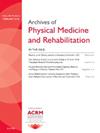急性脑卒中后住院康复期间尿路感染的特征、结果和事件发生时间的预测因素:一项综合队列研究。
IF 3.6
2区 医学
Q1 REHABILITATION
Archives of physical medicine and rehabilitation
Pub Date : 2025-05-01
DOI:10.1016/j.apmr.2024.10.007
引用次数: 0
摘要
目的比较首次被诊断为尿路感染(UTI)的急性中风后住院患者与未被诊断为UTI的住院患者的基线临床和人口统计学特征:设计:回顾性观察队列研究:参与者:住院患者(n=1683):干预措施:不适用:主要结果测量入院时的功能独立性测量(FIM)、功能性行走类别(FAC)。Cox比例危险模型分析了UTI事件发生时间与风险因素之间的关系:在纳入的(n=1683)患者中,有 196 人(11.6%)发生过尿毒症。32.1%的尿毒症发生在入院后的第一周,47.9%的尿毒症发生在入院后的头两周。尿毒症发生时间的中位数(IQR)为入院后 16 天(5-37 天)。最常见的病菌是大肠埃希菌(40.5%)、肺炎克雷伯菌(23.7%)和铜绿假单胞菌(6.4%)。感染 UTI 的患者年龄较大,中风严重程度较高,吞咽困难、高血压、忽视、双侧情感障碍、心房颤动、偏瘫的比例较高,功能独立程度较低,FAC 较低。我们发现两组患者在性别、卒中类型(缺血性或出血性)、入院时间、失语症、糖尿病、血脂异常、慢性阻塞性肺病、主要受累侧和受教育程度方面没有差异。尿毒症患者的康复效果明显较差,包括出院FIM和FAC较低、LOS较长、FIM效率较低和FIM效果较差。多变量 Cox 比例危险度确定了高血压 HR=1.60(1.13-2.27)、入院 FIM HR=0.98(0.97-0.99)、入院 BMI HR=0.96(0.93-0.99)和带导管入院 HR= 1.80(1.22-2.64)是首次 UTI 事件发生时间的重要预测因素(一致性指数 = 0.754):尿毒症的识别、特征描述和预测因素可支持急性卒中后的缓解策略,最大限度地减少尿毒症相关并发症,优化康复效果。本文章由计算机程序翻译,如有差异,请以英文原文为准。
Characterization, Outcomes, and Time to Event Predictors of Urinary Tract Infections Acquired During Postacute Stroke Inpatient Rehabilitation: A Comprehensive Cohort Study
Objectives
To (1) compare baseline clinical and demographic characteristics of postacute stroke inpatients who were diagnosed with first-time urinary tract infection (UTI) versus inpatients who were not; (2) compare rehabilitation outcomes between both groups; and (3) examine associations between time to UTI event and risk factors.
Design
Retrospective observational cohort study.
Setting
Institution for inpatient neurologic rehabilitation.
Participants
Inpatients (n=1683) admitted within 3 months poststroke to a rehabilitation facility between 2005 and 2023.
Interventions
Not applicable.
Main Outcome Measures
Functional independence measure (FIM), functional ambulation categories (FACs) at admission. Cox proportional hazard models analyzed the association between UTI event timing and risk factors.
Results
Of the (n=1683) included patients, 196 (11.6%) experienced a UTI. In 32.1% of cases, the UTI occurred during the first week after admission to rehabilitation and 47.9% of UTIs occurred during the first 2 weeks. The median (interquartile range) time to UTI was 16 (5-37) days since admission. Most common germs were Escherichia coli (40.5%), Klebsiella pneumoniae (23.7%), and Pseudomonas aeruginosa (6.4%). Patients who acquired a UTI had older age, higher stroke severity, higher proportion of dysphagia, hypertension, neglect, bilateral affectation, atrial fibrillation, hemiplegia, lower levels of functional independence, and lower FAC. We identified no differences in gender, type of stroke (ischemic or hemorrhagic), time to admission, aphasia, diabetes, dyslipidemia, chronic obstructive pulmonary disease, dominant side affected, and educational level between both groups. Patients with UTI presented significantly poorer rehabilitation outcomes including lower discharge FIM and FAC, larger length of stay, lower FIM efficiency, and decreased FIM effectiveness.
Multivariable Cox proportional hazards identified hypertension HR=1.60 (1.13-2.27), admission FIM HR=0.98 (0.97-0.99), admission body mass index HR=0.96 (0.93-0.99), and admitted with catheter HR=1.80 (1.22-2.64) as significant predictors of time to first UTI event (Concordance-index=0.754).
Conclusions
UTIs identification, characterization, and predictive factors can support postacute stroke mitigation strategies to minimize UTI-related complications and optimize rehabilitation outcomes.
求助全文
通过发布文献求助,成功后即可免费获取论文全文。
去求助
来源期刊
CiteScore
6.20
自引率
4.70%
发文量
495
审稿时长
38 days
期刊介绍:
The Archives of Physical Medicine and Rehabilitation publishes original, peer-reviewed research and clinical reports on important trends and developments in physical medicine and rehabilitation and related fields. This international journal brings researchers and clinicians authoritative information on the therapeutic utilization of physical, behavioral and pharmaceutical agents in providing comprehensive care for individuals with chronic illness and disabilities.
Archives began publication in 1920, publishes monthly, and is the official journal of the American Congress of Rehabilitation Medicine. Its papers are cited more often than any other rehabilitation journal.

 求助内容:
求助内容: 应助结果提醒方式:
应助结果提醒方式:


